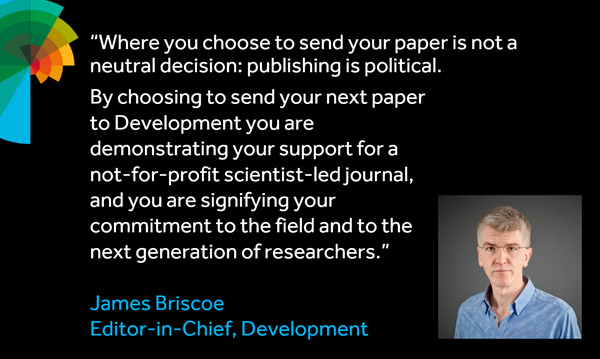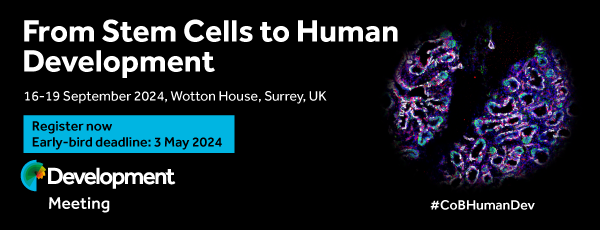Issues
-
Cover image
Cover Image

Cover: Mosaic expression of EGFP by endothelial cells in the retina, detected using an anti-GFP antibody. Mosaic labelling of individual cells highlights the diversity of endothelial cell morphologies, from elongated cells in mature vessels (bottom of image) to spiky, migratory tip cells in the sprouting part of the retina (top of image). See Research article by Grant et al. (dev199581).
- PDF Icon PDF LinkTable of contents
- PDF Icon PDF LinkIssue info
RESEARCH HIGHLIGHTS
DEVELOPMENTAL TWISTS
INTERVIEW
SPOTLIGHT
Cell state transitions: definitions and challenges
Summary: This brief Spotlight article summarises some of the main messages that emerged from discussions at The Company of Biologists virtual workshop, ‘Cell State Transitions: Approaches, Experimental Systems and Models’.
REVIEW
Microtubule-dependent subcellular organisation of pluripotent cells
Summary: This Review details discoveries in microtubule organisation of early embryos and elucidates how the cytoskeleton-organelle interactome is an integral contributor to pluripotent cell identity in vivo and in vitro.
HUMAN DEVELOPMENT
RNA profiling of laser microdissected human trophoblast subtypes at mid-gestation reveals a role for cannabinoid signaling in invasion
Summary: Transcriptomic and proteomic profiling of laser captured human trophoblasts showed that placental cells lining uterine arteries express cannabinoid receptor 1. Functional analyses suggest that endogenous/exogenous cannabinoids could affect placentation.
STEM CELLS AND REGENERATION
YAP establishes epiblast responsiveness to inductive signals for germ cell fate
Highlighted Article: YAP, an intracellular mediator of the Hippo signaling pathway, establishes epiblast competency for germ cell differentiation through activation of the WNT pathway.
Wnt/β-catenin signalling is dispensable for adult neural stem cell homeostasis and activation
Highlighted Article: Wnt/β-catenin signalling stimulation promotes the exit from quiescence and differentiation of adult hippocampal neural stem cells but is dispensable for homeostatic neurogenesis in the dentate gyrus of young mice.
RESEARCH ARTICLES
Development of follicular dendritic cells in lymph nodes depends on retinoic acid-mediated signaling
Summary: Early postnatal retinoic acid signaling is required for proper development of follicular dendritic cells in lymph nodes in mice.
The histone acetyltransferase HBO1 promotes efficient tip cell sprouting during angiogenesis
Highlighted Article: The histone acetyltransferase HBO1 is necessary for widespread chromatin organisation through its acetylation activity at H3K14, which promotes efficient tip cell behaviour during angiogenesis.
Lamb1a regulates atrial growth by limiting second heart field addition during zebrafish heart development
Summary: Analysis of heart development in lamb1a zebrafish mutants reveals a role for laminin in restricting heart growth during morphogenesis, preventing excessive contractility-driven addition of progenitor cells to the venous pole of the heart.
Formal proof of the requirement of MESP1 and MESP2 in mesoderm specification and their transcriptional control via specific enhancers in mice
Summary: Mouse lines created using genome editing technology reveal that MESP1 and MESP2 are required for mesoderm specification in a dose-dependent manner.
BLMP-1 promotes developmental cell death in C. elegans by timely repression of ced-9 transcription
Summary: The zinc-finger transcription factor BLMP-1, which controls larval development timing, also regulates embryonic tail-spike cell death initiation by repression of ced-9 transcription in C. elegans.
PCMD-1 bridges the centrioles and the pericentriolar material scaffold in C. elegans
Highlighted Article: PCMD-1 interacts with SPD-5, PLK-1 and SAS-4, forming a functional bridge between the two centrosomal components in C. elegans.
Trp53 ablation fails to prevent microcephaly in mouse pallium with impaired minor intron splicing
Summary: Ablation of Trp53 fails to rescue microcephaly caused by inhibition of the minor spliceosome in the developing mouse cortex, and uncovers a role for p53 in DNA damage.
RASSF8-mediated transport of Echinoid via the exocyst promotes Drosophila wing elongation and epithelial ordering
Highlighted Article: Cell junction remodelling is essential for tissues to acquire their shape during development. RASSF8 is required for exocyst-mediated transport of the adherens junction component Echinoid to promote Drosophila wing elongation.
Reduction of cortical parvalbumin-expressing GABAergic interneurons in a rodent hyperoxia model of preterm birth brain injury with deficits in social behavior and cognition
Summary: Oxidative stress and impaired oligodendroglia-interneuron crosstalk, via decreased oligodendroglial GDNF expression, might cause the reduction of cortical PVALB+ interneurons. Observed ADHD- and ASD-like behavior could be explained by the pathologies of cortical interneurons.
Call for papers: Uncovering Developmental Diversity

Development invites you to submit your latest research to our upcoming special issue: Uncovering Developmental Diversity. This issue will be coordinated by our academic Editor Cassandra Extavour (Harvard University, USA) alongside two Guest Editors: Liam Dolan (Gregor Mendel Institute of Molecular Plant Biology, Austria) and Karen Sears (University of California Los Angeles, USA).
Choose Development in 2024

In this Editorial, Development Editor-in-Chief James Briscoe and Executive Editor Katherine Brown explain how you support your community by publishing in Development and how the journal champions serious science, community connections and progressive publishing.
Journal Meeting: From Stem Cells to Human Development

Register now for the 2024 Development Journal Meeting From Stem Cells to Human Development. Early-bird registration deadline: 3 May. Abstract submission deadline: 21 June.
Pluripotency of a founding field: rebranding developmental biology

This collaborative Perspective, the result of a workshop held in 2023, proposes a set of community actions to increase the visibility of the developmental biology field. The authors make recommendations for new funding streams, frameworks for collaborations and mechanisms by which members of the community can promote themselves and their research.
Read & Publish Open Access publishing: what authors say

We have had great feedback from authors who have benefitted from our Read & Publish agreement with their institution and have been able to publish Open Access with us without paying an APC. Read what they had to say.



